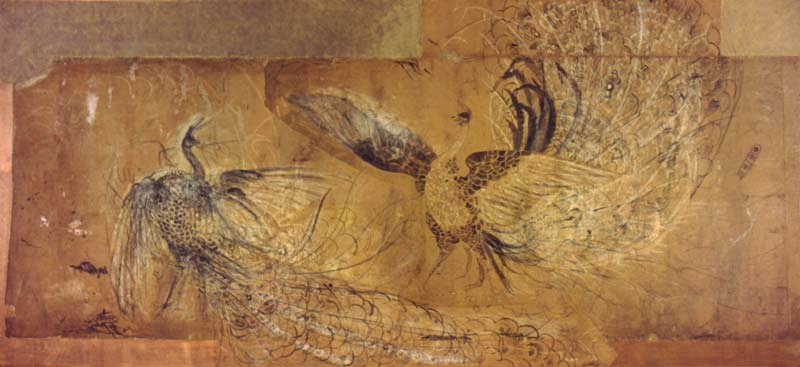Home > Catalogue > Browse > Cartoon of rich and poor Peacocks << >>
Composition
This is a full scale cartoon for the panel of Rich and Poor Peacocks on the south wall of Harmony in Blue and Gold: The Peacock Room [YMSM 178].
Describing the Peacock Room, Whistler told the Pennells, '[I] just painted it as I went on, without design or sketch - it grew as I painted.' 1 This is manifestly not true of the panel of the rich and poor peacocks, given the existence of this full scale cartoon.
Technique
In chalk, with details freely painted in wash, it is by far the largest drawing Whistler produced. The first stage in preparing the cartoon was a drawing in black and white chalk. This was gone over quickly in grey wash. The brush used was 3-4 mm. (1 1/8-1 1/2") wide, but some of the final strokes were painted with a broad brush, ca 7 mm ( 2 3/4") wide and a few strokes are 14 mm (5 1/2") wide. In a few places pencil lines were used to define details.
Then the drawing was incised for transfer. This was done so energetically that it cut right through the paper at times. In addition there is a deeply incised line some 5 mm (2") outside the outline defining each peacock. The wash did not follow the chalk at all times, nor did the incising follow either the wash or chalk lines precisely. The incised lines of tracing were more precise than the sketchy brushstrokes. On the face of the right peacock, either the act of making the incised line has removed the original drawing, or the incised line was used to define details, without preliminary drawing.
Originally the tail swept up steeply and forward over the head. Brushwork modified the angle and filled in the detail. Many curves of feathers drawn in chalk were not gone over in wash, and the incising of lines was perfunctory, leaving the artist to recreate the design without too much constraint on the canvas. In its present state, the top of his left wing is a mess, pale and rubbed. The wash is somewhat muddy on the right wing and tail where it has picked up too much chalk. There was a lot of rubbing out of the white chalk above the right wing. Pencil appears to have been used a little in the final stage, in some details like the skinny feather at the top.
To the right is an isolated experiment, where Whistler tried out a pattern for the eyes of the big peacock feathers, quickly abandoned in favour of a few loosely curving impressions.
There appear to have been a lot of alterations to the peacock on the left. White chalk lines, and a white rubbed out area, surround it, in particular at the head. The head and wings were tried out in different positions. It is not clear whether the feathers scraped on the neck were intended for transfer, or were just part of the drawing process. The variety of textures, including this scraping, give the small feathers a fine, engraved quality, and catch the light, adding a glow to the drawing. There is a feather pattern to left of the peacock, possibly meant to represent raised feathers.
The mass of feathers in black and white chalk and wash, looked at closely, is a muddle, but from a distance is full of movement, a splendid waterfall of feathers. The wash has become muddy on the top of the wings and along the neck of the bird.
The final painting of gold on blue completed the process of stylizing every detail into a consistent, elegant decoration. In the process some of the vigour of the original design was lost. The cartoon gives a true representation of Whistler's intentions. 2
Conservation History
Rosalind Birnie Philip (1873-1958) wrote to Charles Lang Freer (1856-1919) on 12 November 1903 that she had found 'the sketches of the two fighting peacocks, of the peacock room … wonderful in execution' and she had them mounted on canvas. 3
The paper of the Cartoon has been repeatedly folded and torn and is much rubbed, stained and abraded. Sections have been repaired and replaced. Some of the tears originated with the incising of the cartoon.
The painting itself was restored in the 1980s, and now reveals the delicacy of the original brushwork.
Last updated: 7th December 2020 by Margaret







